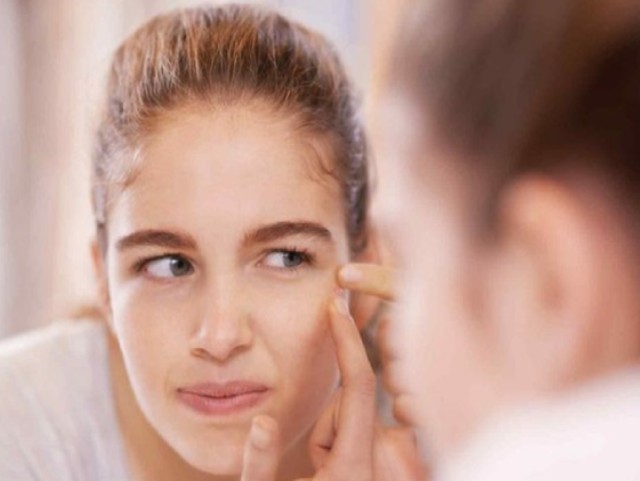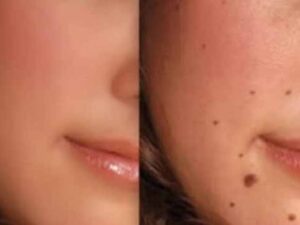Tired of being called ‘Pizza Face’? Acne does not discriminate based on gender, race, age, wealth or social status. Acne is controlled by hormonal fluctuations that are hard to tame. This often makes acne management a frustrating affair. Read on for a better understanding about your zits
1) The location of your zits are important clues to your inner health
– Most of us have a propensity to develop acne on certain areas of our face alone. Ever wonder what that means? Turns out, ancient Chinese face reading is pretty accurate in it’s assessment even to this day.
– Acne on the forehead is generally an indication of digestive disorders or latent bacterial infections. Add more fruits, vegetables and water to your diet. Use medicated shampoos if you also suffer from dandruff. Do not use leave-on hair products. And do not let your hair fall on your forehead. These are the most common location of acne in adolescents.
– Acne between and around the eyebrows is an indication of an unhealthy liver and gall bladder. Cut back on rich food and alcohol.
– Acne on the upper cheeks is an indication of unhealthy lungs. Avoid smoking and stay away from dust and pollen.
– Acne on the sides of your cheek, especially if they only affect one cheek, could be a result of touching your face with dirty hands, smoking, sleeping on dirty pillows or bacteria picked up from your cell phone.
– Acne on your ears means your kidneys are suffering. Drink more water and cut down on salt and caffeine.
– Acne on the lower cheeks could be an indication of infected gums and/or dental cavities.
– Acne on the nose is a sign of an unhealthy pancreas. This could also be a result of constipation, bloating and indigestion. Remember to exfoliate regularly.
– Acne along the jawline or upper neck is an indication of hormonal imbalance, stress and/or pelvic infections
– Acne on the center of the chin suggests your stomach and small intestine are unclean. Avoid rich fatty and unhygienic food. Cut back on sugar. Incorporate more fiber and Omega-3 fatty acids in your diet. Spearmint tea is good for you.
– Acne on the chest and back may be an indication of excess heat and sweating, poor hygiene or fungal infections.
2) Is there an acne diet?
For years, women believed that chocolates and fried food cause acne break outs. And for years, dermatologists have insisted that there is no scientific evidence to back this statement. However, weight and obesity (often a fall back of junk food) can lead to hormonal imbalances. Which lead to acne. Dairy products, sugary and starchy foods are the main culprits, rather than fat. A constipated gut can also upset your delicate hormonal balance. This is the price we pay for modernity. Too much meat and processed food in our diet leads to constipation. Balance your craving for meat and sweets with plenty of water, exercise and fiber in your diet. Probiotics can regulate your gut. A diet rich in zinc, selenium and Vitamin A (for eg. seafood, shellfish, eggs, brown rice, all orange or yellow fruits and vegetables) can help fight acne.
3) Myth- You don’t need to treat pimples. They will go away eventually.
This is not always true. Most men will outgrow their acne by their late 20s, as a man’s body does not go through many hormonal fluctuations. But a woman’s body goes through major hormonal upheavals during adolescence, later in pregnancy, and once more around the menopausal years. I have seen acne in girls as young as 10 to women as mature as 55! In fact, dermatologists are increasingly seeing women who get a pimple problem for the first time in their 30s or 40s. We even see the occasional male patient who will get large painful acne in their 40s or 50s. It is true that acne is largely a cosmetic concern, unless it is a symptom of an underlying hormonal or reproductive disorder. However the marks and scars left by acne can last a lifetime and create severe emotional stress. A 15 year old boy may not be bothered to treat his acne. But 10 years later, he may blame the scars for ruining his dating prospects. The scars from acne may prevent some from getting a lucrative job in certain careers (say, media, sales & marketing, the hospitality business) where looks and presentation matter. Acne should be treated aggressively in order to prevent scarring.
4) Myth- Home remedies and facials are the best and safest treatment for acne
Not necessarily! Turmeric, sandalwood powder, aloe vera and diluted garlic juice work fine for mild acne. But it is a fallacy to believe that herbal means safe. Garlic juice and tea tree oil can burn and irritate the skin. Just as some people are allergic to aloe vera pulp taken fresh off the leaf! A lot of teens use toothpaste as a cheap and easily available acne remedy. D-U-M-B! Some toothpastes contain menthol or benzoyl peroxide which can reduce inflammation. But the other ingredients in toothpaste can burn and tan your skin, especially if your skin is on the duskier side. Toothpaste can only temporarily reduce the redness of a pimples, so women end up applying toothpaste frequently, or else the zit is back. This is harmful and counter-productive. Toothpastes are meant to clean your teeth, which are hard and tough. Your skin is soft and sensitive and was never meant to be molested by toothpaste!
5) What’s new in Acne management?
It’s a little device called “Zeno”. This US FDA approved hand-held device looks like a tiny cell phone. It works by delivering a tiny pulse of heat to your acne , destroying the bacteria within minutes and drying out the acne. But experts agree that it only works on mild acne. There are other devices like the TRIA skin clarifying system which uses blue light. Or the Tanda Zap, which combines blue light, sonic vibration and heat to fade blemishes in 24 hours. These are great devices if you suffer from zit phobia. Or need to urgently get rid of pesky acne without having to risk using steroid based creams, which will ultimately do more harm in the long run.
6) Are laser treatments helpful?
Lasers work by using heat and radiation to kill the acne bacteria. This can be effectively achieved using antibiotics as well. That is why lasers are not the first line of management. It is a good option if you are allergic to antibiotics or cannot take them since you’re trying to get pregnant. Laser treatments can be done along with the antibiotic course to supplement their effect. Some of these devices work by shrinking the oil glands, and these devices are generally more effective. For pale Caucasian skin, another light based treatment called Photodynamic Therapy, is a proven and effective remedy. This treatment is painful and risks severe sunburns in dusky toned skin. But it targets the bacteria as well as the oil glands, so the results last longer. All laser and light based treatments are more expensive and not accessible to all.
That’s a wrap for this month’s issue folks. Do remember that medical advice in this column are of a generic nature. Ultimately each person’s acne related sufferings are unique and need a customized approach. This article is not a substitute for a face to face medical consultation.




